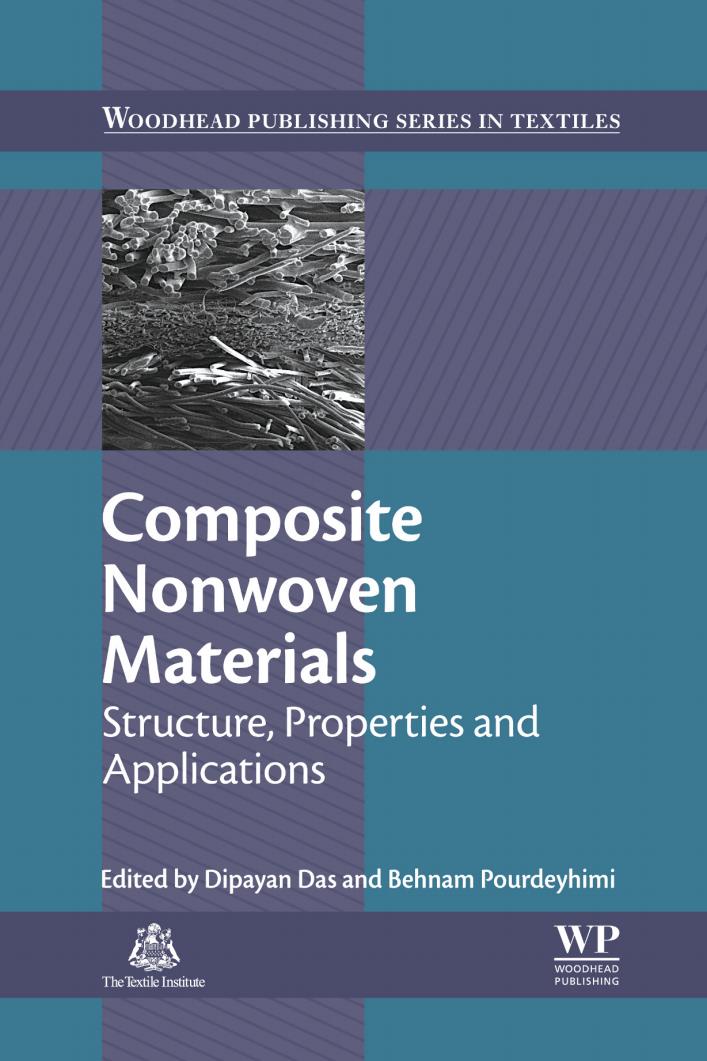
WOODHEAD PUBLISHING SERIES IN TEXTILES Composite Nonwoven Materials Structure,Properties and Applications Edited by Dipayan Das and Behnam Pourdeyhimi WP WOODHEAD The Textile Institute PUBLISHING
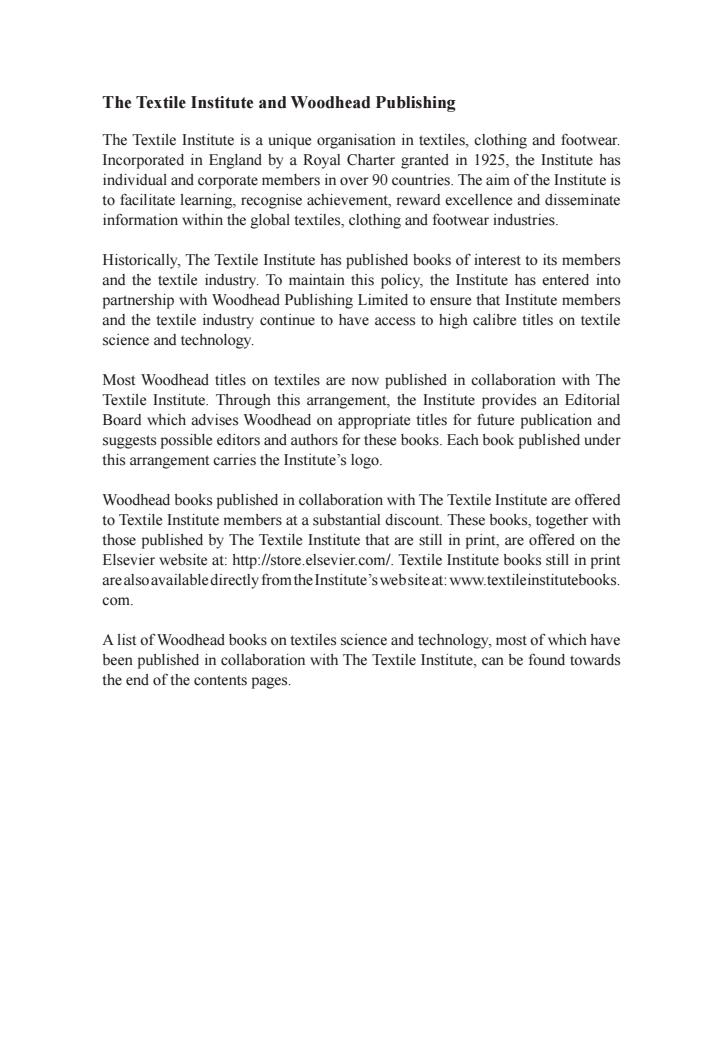
The Textile Institute and Woodhead Publishing The Textile Institute is a unique organisation in textiles,clothing and footwear. Incorporated in England by a Royal Charter granted in 1925,the Institute has individual and corporate members in over 90 countries.The aim of the Institute is to facilitate learning,recognise achievement,reward excellence and disseminate information within the global textiles,clothing and footwear industries. Historically,The Textile Institute has published books of interest to its members and the textile industry.To maintain this policy,the Institute has entered into partnership with Woodhead Publishing Limited to ensure that Institute members and the textile industry continue to have access to high calibre titles on textile science and technology. Most Woodhead titles on textiles are now published in collaboration with The Textile Institute.Through this arrangement,the Institute provides an Editorial Board which advises Woodhead on appropriate titles for future publication and suggests possible editors and authors for these books.Each book published under this arrangement carries the Institute's logo. Woodhead books published in collaboration with The Textile Institute are offered to Textile Institute members at a substantial discount.These books,together with those published by The Textile Institute that are still in print,are offered on the Elsevier website at:http://store.elsevier.com/.Textile Institute books still in print are alsoavailable directly from the Institute's website at:www.textileinstitutebooks. com. A list of Woodhead books on textiles science and technology,most of which have been published in collaboration with The Textile Institute,can be found towards the end of the contents pages
The Textile Institute and Woodhead Publishing The Textile Institute is a unique organisation in textiles, clothing and footwear. Incorporated in England by a Royal Charter granted in 1925, the Institute has individual and corporate members in over 90 countries. The aim of the Institute is to facilitate learning, recognise achievement, reward excellence and disseminate information within the global textiles, clothing and footwear industries. Historically, The Textile Institute has published books of interest to its members and the textile industry. To maintain this policy, the Institute has entered into partnership with Woodhead Publishing Limited to ensure that Institute members and the textile industry continue to have access to high calibre titles on textile science and technology. Most Woodhead titles on textiles are now published in collaboration with The Textile Institute. Through this arrangement, the Institute provides an Editorial Board which advises Woodhead on appropriate titles for future publication and suggests possible editors and authors for these books. Each book published under this arrangement carries the Institute’s logo. Woodhead books published in collaboration with The Textile Institute are offered to Textile Institute members at a substantial discount. These books, together with those published by The Textile Institute that are still in print, are offered on the Elsevier website at: http://store.elsevier.com/ . Textile Institute books still in print are also available directly from the Institute’s web site at: www.textileinstitutebooks. com . A list of Woodhead books on textiles science and technology, most of which have been published in collaboration with The Textile Institute, can be found towards the end of the contents pages
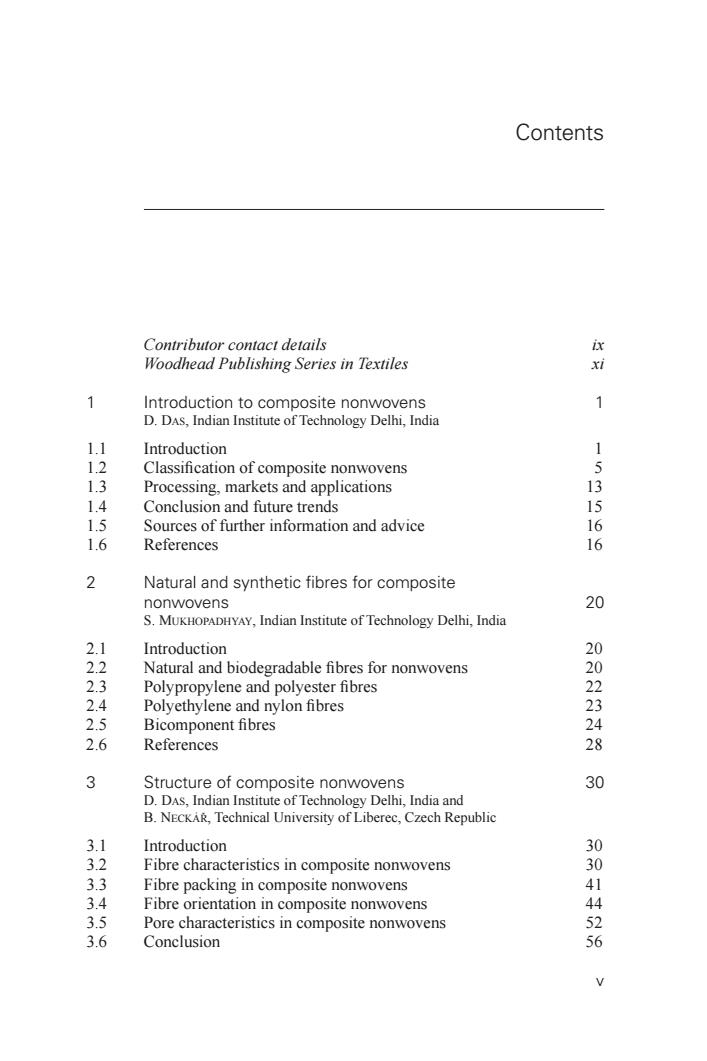
Contents Contributor contact details ix Woodhead Publishing Series in Textiles xi 1 Introduction to composite nonwovens 1 D.DAs,Indian Institute of Technology Delhi,India 1.1 Introduction 1 1.2 Classification of composite nonwovens 5 1.3 Processing,markets and applications 13 1.4 Conclusion and future trends 15 1.5 Sources of further information and advice 16 1.6 References 16 2 Natural and synthetic fibres for composite nonwovens 20 S.MUKHOPADHYAY,Indian Institute of Technology Delhi,India 2.1 Introduction 20 2.2 Natural and biodegradable fibres for nonwovens 20 2.3 Polypropylene and polyester fibres 2 2.4 Polyethylene and nylon fibres 23 2.5 Bicomponent fibres 24 2.6 References 28 3 Structure of composite nonwovens 30 D.DAs,Indian Institute of Technology Delhi,India and B.NECKAR,Technical University of Liberec,Czech Republic 3.1 Introduction 30 3.2 Fibre characteristics in composite nonwovens 30 3.3 Fibre packing in composite nonwovens 41 3.4 Fibre orientation in composite nonwovens 4 3.5 Pore characteristics in composite nonwovens 52 3.6 Conclusion 5
v Contributor contact details ix Woodhead Publishing Series in Textiles xi 1 Introduction to composite nonwovens 1 D. DAS, Indian Institute of Technology Delhi, India 1.1 Introduction 1 1.2 Classifi cation of composite nonwovens 5 1.3 Processing, markets and applications 13 1.4 Conclusion and future trends 15 1.5 Sources of further information and advice 16 1.6 References 16 2 Natural and synthetic fi bres for composite nonwovens 20 S. MUKHOPADHYAY, Indian Institute of Technology Delhi, India 2.1 Introduction 20 2.2 Natural and biodegradable fi bres for nonwovens 20 2.3 Polypropylene and polyester fi bres 22 2.4 Polyethylene and nylon fi bres 23 2.5 Bicomponent fi bres 24 2.6 References 28 3 Structure of composite nonwovens 30 D. DAS, Indian Institute of Technology Delhi, India and B. NECKÁŘ, Technical University of Liberec, Czech Republic 3.1 Introduction 30 3.2 Fibre characteristics in composite nonwovens 30 3.3 Fibre packing in composite nonwovens 41 3.4 Fibre orientation in composite nonwovens 44 3.5 Pore characteristics in composite nonwovens 52 3.6 Conclusion 56 Contents
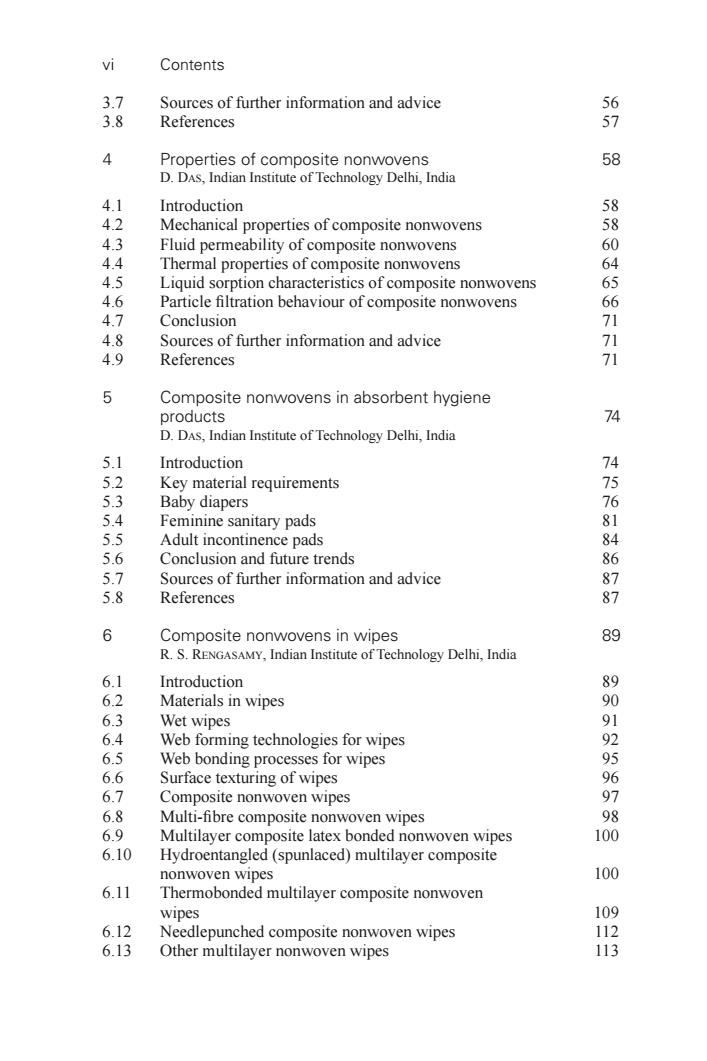
VI Contents 3.7 Sources of further information and advice 5 3.8 References 7 4 Properties of composite nonwovens 58 D.DAs,Indian Institute of Technology Delhi,India 4.1 Introduction 58 4.2 Mechanical properties of composite nonwovens 58 4.3 Fluid permeability of composite nonwovens 60 4.4 Thermal properties of composite nonwovens 64 4.5 Liquid sorption characteristics of composite nonwovens 65 4.6 Particle filtration behaviour of composite nonwovens 66 4.7 Conclusion 71 4.8 Sources of further information and advice 71 4.9 References 1 5 Composite nonwovens in absorbent hygiene products 74 D.DAS,Indian Institute of Technology Delhi,India 5.1 Introduction 74 5.2 Key material requirements 5 5.3 Baby diapers 76 5.4 Feminine sanitary pads 81 5.5 Adult incontinence pads 84 5.6 Conclusion and future trends 86 5.7 Sources of further information and advice 87 5.8 References 87 6 Composite nonwovens in wipes 89 R.S.RENGASAMY,Indian Institute of Technology Delhi,India 6.1 Introduction 89 6.2 Materials in wipes 90 6.3 Wet wipes 91 6.4 Web forming technologies for wipes 92 6.5 Web bonding processes for wipes 95 6.6 Surface texturing of wipes 6 6.7 Composite nonwoven wipes 97 6.8 Multi-fibre composite nonwoven wipes 98 6.9 Multilayer composite latex bonded nonwoven wipes 100 6.10 Hydroentangled(spunlaced)multilayer composite nonwoven wipes 100 6.11 Thermobonded multilayer composite nonwoven wipes 109 6.12 Needlepunched composite nonwoven wipes 112 6.13 Other multilayer nonwoven wipes 113
vi Contents 3.7 Sources of further information and advice 56 3.8 References 57 4 Properties of composite nonwovens 58 D. DAS, Indian Institute of Technology Delhi, India 4.1 Introduction 58 4.2 Mechanical properties of composite nonwovens 58 4.3 Fluid permeability of composite nonwovens 60 4.4 Thermal properties of composite nonwovens 64 4.5 Liquid sorption characteristics of composite nonwovens 65 4.6 Particle fi ltration behaviour of composite nonwovens 66 4.7 Conclusion 71 4.8 Sources of further information and advice 71 4.9 References 71 5 Composite nonwovens in absorbent hygiene products 74 D. DAS, Indian Institute of Technology Delhi, India 5.1 Introduction 74 5.2 Key material requirements 75 5.3 Baby diapers 76 5.4 Feminine sanitary pads 81 5.5 Adult incontinence pads 84 5.6 Conclusion and future trends 86 5.7 Sources of further information and advice 87 5.8 References 87 6 Composite nonwovens in wipes 89 R. S. RENGASAMY, Indian Institute of Technology Delhi, India 6.1 Introduction 89 6.2 Materials in wipes 90 6.3 Wet wipes 91 6.4 Web forming technologies for wipes 92 6.5 Web bonding processes for wipes 95 6.6 Surface texturing of wipes 96 6.7 Composite nonwoven wipes 97 6.8 Multi- fi bre composite nonwoven wipes 98 6.9 Multilayer composite latex bonded nonwoven wipes 100 6.10 Hydroentangled (spunlaced) multilayer composite nonwoven wipes 100 6.11 Thermobonded multilayer composite nonwoven wipes 109 6.12 Needlepunched composite nonwoven wipes 112 6.13 Other multilayer nonwoven wipes 113
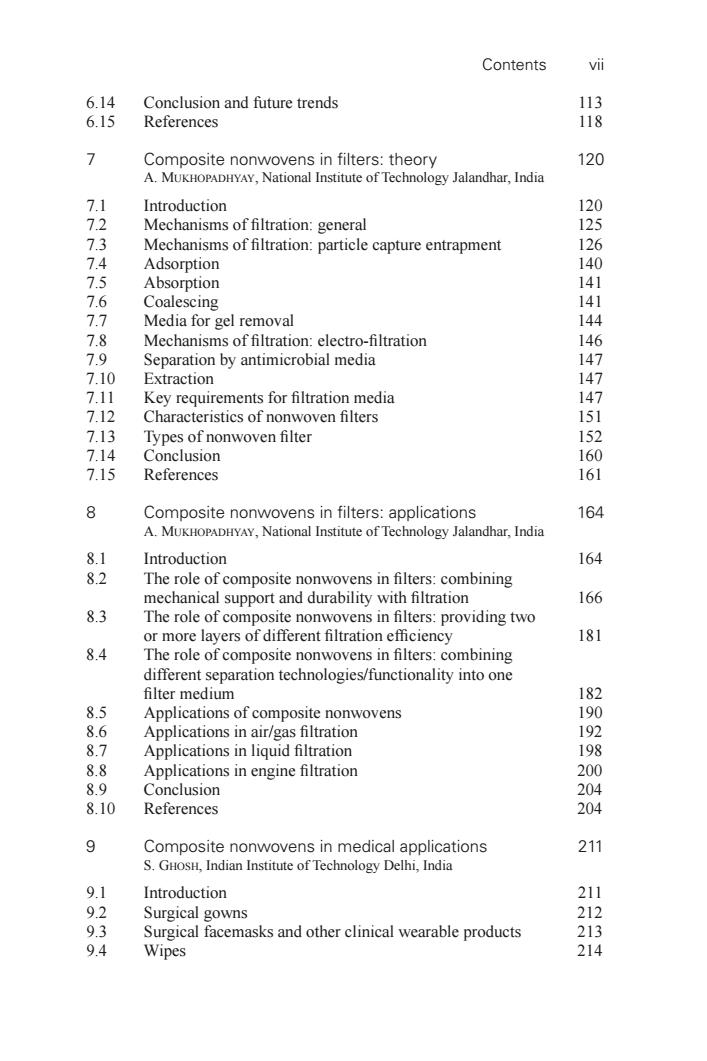
Contents vil 6.14 Conclusion and future trends 113 6.15 References 118 7 Composite nonwovens in filters:theory 120 A.MUKHOPADHYAY,National Institute of Technology Jalandhar,India 7.1 Introduction 120 7.2 Mechanisms of filtration:general 125 7.3 Mechanisms of filtration:particle capture entrapment 126 7.4 Adsorption 140 7.5 Absorption 141 7.6 Coalescing 141 7.7 Media for gel removal 144 7.8 Mechanisms of filtration:electro-filtration 146 7.9 Separation by antimicrobial media 147 7.10 Extraction 147 7.11 Key requirements for filtration media 147 7.12 Characteristics of nonwoven filters 151 7.13 Types of nonwoven filter 152 7.14 Conclusion 160 7.15 References 161 8 Composite nonwovens in filters:applications 164 A.MUKHOPADHYAY,National Institute of Technology Jalandhar,India 8.1 Introduction 164 8.2 The role of composite nonwovens in filters:combining mechanical support and durability with filtration 166 8.3 The role of composite nonwovens in filters:providing two or more layers of different filtration efficiency 181 8.4 The role of composite nonwovens in filters:combining different separation technologies/functionality into one filter medium 182 8.5 Applications of composite nonwovens 190 8.6 Applications in air/gas filtration 192 8.7 Applications in liquid filtration 198 8.8 Applications in engine filtration 200 8.9 Conclusion 204 8.10 References 204 9 Composite nonwovens in medical applications 211 S.GHOSH,Indian Institute of Technology Delhi,India 9.1 Introduction 211 9.2 Surgical gowns 212 9.3 Surgical facemasks and other clinical wearable products 213 9.4 Wipes 214
Contents vii 6.14 Conclusion and future trends 113 6.15 References 118 7 Composite nonwovens in fi lters: theory 120 A. MUKHOPADHYAY, National Institute of Technology Jalandhar, India 7.1 Introduction 120 7.2 Mechanisms of fi ltration: general 125 7.3 Mechanisms of fi ltration: particle capture entrapment 126 7.4 Adsorption 140 7.5 Absorption 141 7.6 Coalescing 141 7.7 Media for gel removal 144 7.8 Mechanisms of fi ltration: electro- fi ltration 146 7.9 Separation by antimicrobial media 147 7.10 Extraction 147 7.11 Key requirements for fi ltration media 147 7.12 Characteristics of nonwoven fi lters 151 7.13 Types of nonwoven fi lter 152 7.14 Conclusion 160 7.15 References 161 8 Composite nonwovens in fi lters: applications 164 A. MUKHOPADHYAY, National Institute of Technology Jalandhar, India 8.1 Introduction 164 8.2 The role of composite nonwovens in fi lters: combining mechanical support and durability with fi ltration 166 8.3 The role of composite nonwovens in fi lters: providing two or more layers of different fi ltration effi ciency 181 8.4 The role of composite nonwovens in fi lters: combining different separation technologies/functionality into one fi lter medium 182 8.5 Applications of composite nonwovens 190 8.6 Applications in air/gas fi ltration 192 8.7 Applications in liquid fi ltration 198 8.8 Applications in engine fi ltration 200 8.9 Conclusion 204 8.10 References 204 9 Composite nonwovens in medical applications 211 S. GHOSH, Indian Institute of Technology Delhi, India 9.1 Introduction 211 9.2 Surgical gowns 212 9.3 Surgical facemasks and other clinical wearable products 213 9.4 Wipes 214